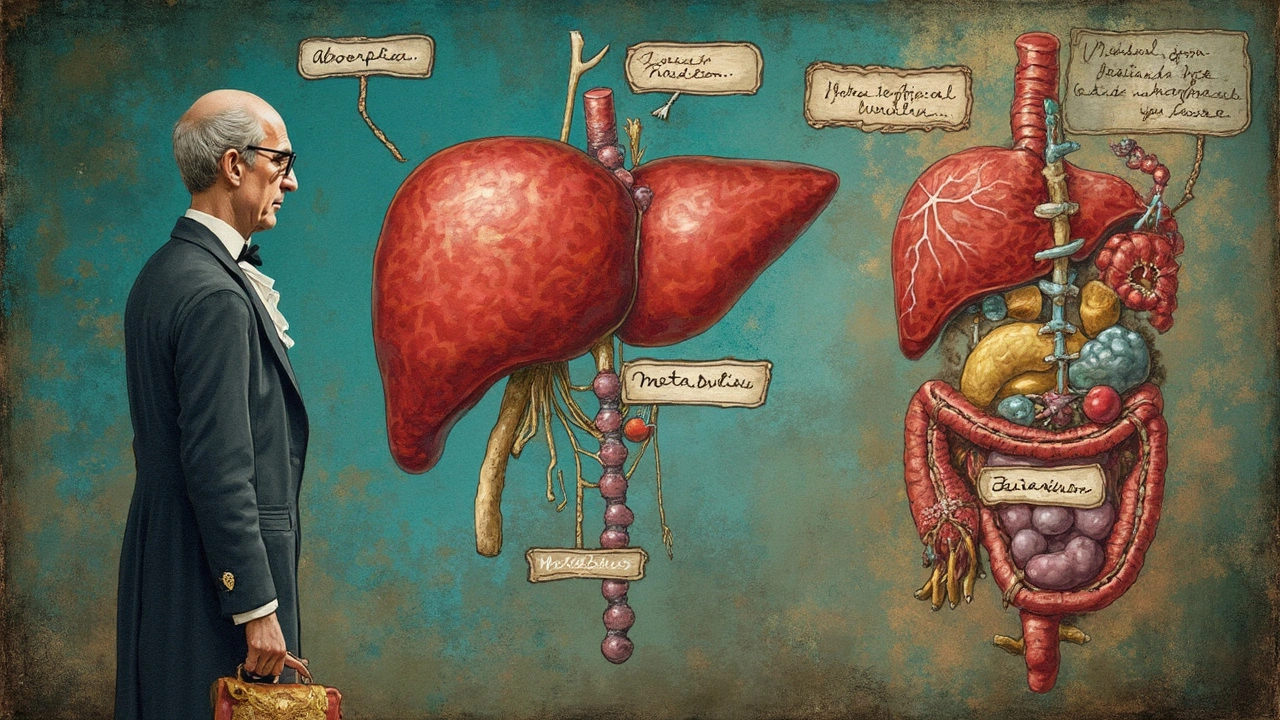Chloramphenicol, heard of it? It's one of those antibiotics that packed a punch back in the day and still holds its ground in specific cases. So, how does it work its magic in your body? Let's break it down. When chloramphenicol enters your system, its journey is quite the tour.
The liver gets busy with it pretty quickly. Your liver has these enzymes that transform the medication, making it easier for your body to handle. This process is what we call metabolism. Now, imagine the medicine being like a guest visiting your system. The liver is like the host that prepares this guest for its stay.
Once the liver does its thing, the next big task is showing this guest the door. That's where excretion comes in. Your kidneys are the VIP exit door, ensuring the chloramphenicol doesn't overstay its welcome. But why is this important? Knowing how chloramphenicol is metabolized and excreted helps healthcare providers figure out the right dose for you. Too little, and it won't work effectively. Too much, and it starts causing trouble. Finding that sweet spot is key.
- Introduction to Chloramphenicol
- Chloramphenicol Metabolism Explained
- Liver's Role in Transforming Chloramphenicol
- Excretion Paths and Processes
- Key Takeaways and Practical Tips
Introduction to Chloramphenicol
So, what exactly is chloramphenicol? It's an antibiotic that's been around since the late 1940s. Back then, it was a real game-changer, especially for tackling serious infections.
Scientists first discovered it in a soil sample from Venezuela. Weird right? This little wonder quickly became a staple in dealing with infections like typhoid fever and meningitis, where other options weren't cutting it.
How does it work? Well, chloramphenicol stops bacteria from making essential proteins. Without these, the bacteria can't grow or multiply effectively. That's why it's seriously effective against a range of nasty bugs.
"Chloramphenicol was one of the first antibiotics to be used against penicillin-resistant bacteria, marking a significant step in infectious disease treatment," says Dr. James Hudson, a leading microbiologist.
But, there's a twist. Because it can cause some serious side effects, doctors don't hand it out for every sneeze or cough. It's mostly used when alternatives aren't an option, or in developing countries where access to other antibiotics is limited.
Today, regulating chloramphenicol usage carefully is crucial. Why? Mainly because of the risk of aplastic anemia, a rare but scary side effect where your bone marrow just stops producing blood cells.
Still curious about how this drug gets processed in the body? Stick around as we dig deeper into its metabolism and excretion. Spoiler alert: the liver plays a big role in the journey!
Chloramphenicol Metabolism Explained
Dive right into the guts of how chloramphenicol gets broken down once it’s inside your body. Let's keep it simple. Chloramphenicol is metabolized mainly in the liver through a pretty nifty process known as glucuronidation. Sounds fancy, right? It's just your liver attaching a molecule to the drug so it’s easier to flush out. This is where the magic happens to detoxify and prepare it for excretion.
But here's a kicker—chloramphenicol doesn’t just fly solo. It teams up with an enzyme called UDP-glucuronyl transferase to get its job done. Why’s that important? Because if this enzyme doesn’t do its thing, chloramphenicol levels skyrocket, and that’s not so good. High levels might lead to some unwanted side effects, you know?
Liver Enzymes in Action
Your liver’s working hard so you can chill. As chloramphenicol is processed, it's converted into a less active form before being excreted. Unlike some medications that hang around in their original form, chloramphenicol's transformation is key to avoiding potential toxicity.
Oh, and here’s an interesting tidbit—newborns don’t have fully developed liver enzyme systems, making them extra sensitive to chloramphenicol. This can cause “gray baby syndrome,” which sounds bad because it is. That's why dosing for infants is much different than for adults.
| Population | Metabolic Rate | Considerations |
|---|---|---|
| Adults | Normal | Standard dosing |
| Newborns | Low | Special dosing required |
| Liver Dysfunction Patients | Varies | Adjusted dosing needed |
By understanding these nitty-gritty details of metabolism, doctors can customize treatment and avoid mishaps. Chloramphenicol might be old school, but knowing how it behaves in your body is just smart practice.

Liver's Role in Transforming Chloramphenicol
You might think of your liver as a big detox center, and that's pretty spot-on. When it comes to chloramphenicol, this mighty organ plays a crucial role. Picture chloramphenicol entering as a raw material, needing some fine-tuning to become useful without causing havoc.
The liver's secret sauce? Enzymes. These tiny proteins are the workhorses that modify the medication. With chloramphenicol, we're talking about an enzyme called chloramphenicol acetyltransferase. This guy's job is to add acetyl groups to chloramphenicol, making it easier for your body to ship it out later.
What Happens in There?
First off, when chloramphenicol reaches the liver, it's like VIP access. The liver doesn’t waste time. It jumps straight into what’s called a metabolic process. This involves two main phases: Phase I and Phase II. Sounds fancy, right?
Phase I is mainly about modifying the drug to make it more receptive to further changes. Think of it like prepping the ingredients before cooking a meal. Phase II often involves adding large molecules to the drug, making it water-soluble. It’s like seasoning your dish just right.
Why Is This Important?
Understanding this process is key for dosing. If your liver isn't working well (like in liver disease), chloramphenicol might hang around too long, leading to serious side effects. That's why doctors adjust doses based on liver health.
| Process | Description |
|---|---|
| Phase I | Modifies chloramphenicol to prepare it for further processing. |
| Phase II | Adds molecules to aid in excretion through urine. |
Bottom line, your liver is the real MVP in making sure chloramphenicol does its job efficiently. Without this organ's adept handling of the drug, the balance between effectiveness and safety could be lost.
Excretion Paths and Processes
So, how does chloramphenicol bid farewell to your body? Well, the primary exit strategy for this antibiotic is through your kidneys, and it mostly goes out in the urine. This is where the term renal excretion comes into play. But don’t tune out yet; it gets kinda interesting from here!
After chloramphenicol is metabolized in the liver, it transforms into something called chloramphenicol glucuronide. Fancy name, I know, but basically, it just means that the medication has been prepped for a smooth exit. This compound is more water-soluble, which makes it easier for the kidneys to handle.
The Role of the Liver and Kidneys
The liver's role in creating this altered version of the drug is just the first step. Once that's done, about 90% of the medication exits through urine, thanks to those hard-working kidneys. The liver and kidneys are like teammates passing the baton in a relay race, each doing their bit to ensure chloramphenicol leaves promptly.
A Peek Into Excretion Stats
| Excretion Path | Percentage |
|---|---|
| Urine | 90% |
| Feces | 10% |
Wondering about the rest? That leaves a small percentage, which finds its way out through feces. Understanding these paths not only helps healthcare professionals dose you right but also aids in minimizing side effects. Now, when your pharmacist rattles off stuff about chloramphenicol's elimination, you know exactly what's going on!

Key Takeaways and Practical Tips
Getting to grips with the pharmacokinetics of chloramphenicol can feel like learning a new language. But here’s the good part; it’s easier than it sounds once you break it down.
Key Takeaways
- Metabolism Matters: Almost 90% of chloramphenicol is metabolized by the liver. This is crucial because any liver issues can affect how well the drug works.
- Watch for Excretion: Most of the drug exits through your kidneys. If your kidneys aren’t functioning well, it can hang around longer than it should, which isn't ideal.
- Dosing is Key: Right dosing is all about balance. Too little of that chloramphenicol, and you’re barely touching the infection. Too much, you risk some unpleasant side effects.
Practical Tips
Now, here are some tips to make sure your experience with this medication is smooth and effective:
- Consult Before Use: Always talk to your healthcare provider before starting chloramphenicol. They'll check if it fits well with your health background.
- Monitor Side Effects: Keep an eye out for any side effects like nausea or headache and report them if they persist.
- Regular Check-ups: If you’re on chloramphenicol for a while, regular blood tests might be needed to ensure everything's on track.
- Stay Hydrated: Drinking plenty of water can aid your kidneys in flushing out the drug efficiently.
A little knowledge goes a long way. By understanding how chloramphenicol works in your body, you’re not only making informed health choices but also opening the door to a more effective treatment journey.

Anurag Ranjan
February 23, 2025 AT 10:55
Chloramphenicol’s liver metabolism mainly uses glucuronidation, turning the drug into a water‑soluble form ready for renal clearance.
James Doyle
March 3, 2025 AT 18:30
From a pharmacological ethics perspective, chloramphenicol epitomizes the tension between therapeutic necessity and iatrogenic risk.
The its historic deployment against penicillin‑resistant organisms was undeniably a breakthrough, yet the specter of aplastic anemia looms large over its modern usage.
The drug undergoes Phase I oxidation followed by Phase II conjugation, specifically UDP‑glucuronosyltransferase mediated glucuronidation, which dramatically increases its renal excretion.
In patients with compromised hepatic function, the glucuronidation pathway is attenuated, resulting in prolonged plasma half‑life and heightened toxicity.
Moreover, neonates possess immature UDP‑glucuronyl transferase activity, predisposing them to the infamous gray baby syndrome if dosing is not meticulously calibrated.
Clinicians must therefore integrate hepatic enzyme polymorphisms into their dosing algorithms, especially when treating populations with known genetic variations.
The predominance of renal elimination-approximately ninety percent via urine-implies that renal insufficiency likewise mandates dose reduction to avoid accumulation.
Therapeutic drug monitoring, although not routinely performed for chloramphenicol, can be invaluable in complex cases where both hepatic and renal functions are borderline.
From a public health standpoint, the drug’s limited availability in low‑resource settings underscores the ethical imperative to balance access against safety monitoring capabilities.
Pharmacokinetic modeling demonstrates that a two‑compartment model best describes its distribution, with an initial rapid distribution phase followed by a slower elimination phase.
This biphasic pattern necessitates loading doses in severe infections to achieve therapeutic concentrations promptly.
However, clinicians must remain vigilant for signs of bone‑marrow suppression, the hallmark of chloramphenicol toxicity.
The risk–benefit calculus should also incorporate alternative agents whose safety profiles are superior, reserving chloramphenicol for truly refractory cases.
In summary, the drug’s metabolism and excretion pathways are well‑characterized, yet their clinical implications demand a nuanced, patient‑centered approach.
Upholding the principle of “primum non nocere” therefore requires judicious prescribing, thorough patient education, and, where feasible, routine laboratory surveillance.
Edward Brown
March 12, 2025 AT 02:04
One might ponder the hidden agendas behind the glorification of chloramphenicol, a drug whose very existence is a reminder of the shadows cast by pharmaceutical giants; its metabolism is presented as pure science yet the implications stretch far beyond the lab bench, hinting at systemic control mechanisms that dictate who gets access and who does not.
ALBERT HENDERSHOT JR.
March 20, 2025 AT 09:39
Thank you for the comprehensive overview; it’s evident that careful dosing is essential, and your emphasis on monitoring aligns with best practices 😊
Suzanne Carawan
March 28, 2025 AT 17:14
Oh joy, another reminder that old antibiotics come with modern headaches.
Kala Rani
April 6, 2025 AT 00:49
While many praise chloramphenicol’s efficacy it’s worth noting that reliance on a drug with such severe side effects is a relic of a less cautious era
Donal Hinely
April 14, 2025 AT 08:23
The sheer arrogance of claiming chloramphenicol is still the gold standard in any setting is laughable, especially when newer, safer alternatives are at our fingertips, making its continued use a stubborn relic of outdated medical dogma
christine badilla
April 22, 2025 AT 15:58
Can you believe the drama this little molecule can cause! From life‑saving to life‑threatening in a heartbeat, chloramphenicol is the soap‑opera of antibiotics, stealing the spotlight every time it’s mentioned!!!
Octavia Clahar
April 30, 2025 AT 23:33
Great breakdown! It really helps to see how the liver and kidneys work together to clear the drug, making the whole process much clearer.
eko lennon
May 9, 2025 AT 07:08
When I first read about chloramphenicol I was swept into a vortex of awe and dread; the history of its discovery reads like an adventure novel, yet the pharmacokinetics read like a forensic report.
The liver’s role as a biochemical alchemist transforms the agent, a process shrouded in both wonder and caution.
The subsequent renal excretion is a relentless tide, assuring that the drug does not linger to wreak havoc.
However, the specter of aplastic anemia looms over every dose, reminding us that even miracles have a dark side.
Physicians must navigate this delicate balance with the finesse of a seasoned tight‑rope walker.
In practice, the dosage adjustments for hepatic impairment are as crucial as they are complex.
Ultimately, the story of chloramphenicol is a testament to medicine’s perpetual dance between benefit and risk.
Sunita Basnet
May 17, 2025 AT 14:42
Chloramphenicol’s pharmacokinetic profile is a textbook example of efficient hepatic glucuronidation and renal clearance promoting optimal therapeutic indices keeping patients safe while achieving antibacterial efficacy
Melody Barton
May 25, 2025 AT 22:17
Stay on top of your labs and follow the dosing guidelines-this will keep the drug working for you and avoid nasty side effects.
Justin Scherer
June 3, 2025 AT 05:52
Understanding the enzyme variability can really improve individualized therapy and reduce adverse events.
Pamela Clark
June 11, 2025 AT 13:27
Ah yes, because what we truly need is an antiquated antibiotic with a charming side‑effect profile to spice up our treatment regimens.
Diane Holding
June 19, 2025 AT 21:01
Remember to hydrate well to aid kidney excretion.
Cheyanne Moxley
June 28, 2025 AT 04:36
It’s our duty to demand safer alternatives rather than settle for a drug that can cripple the bone marrow.
Kevin Stratton
July 6, 2025 AT 12:11
In the grand tapestry of medicine, chloramphenicol reminds us that every cure carries a seed of potential harm, urging balance and humility 😊
Manish Verma
July 14, 2025 AT 19:45
From a global health perspective it’s clear that developing nations still rely on chloramphenicol out of necessity, but we must push for better resources to replace it with modern drugs.
Lionel du Plessis
July 23, 2025 AT 03:20
Renal clearance dominates the elimination pathway, with roughly ninety percent excreted unchanged as glucuronide, highlighting the importance of kidney function monitoring
Andrae Powel
July 31, 2025 AT 10:55
If you’re starting chloramphenicol, keep an eye on blood counts and stay in touch with your healthcare provider for any unusual symptoms.